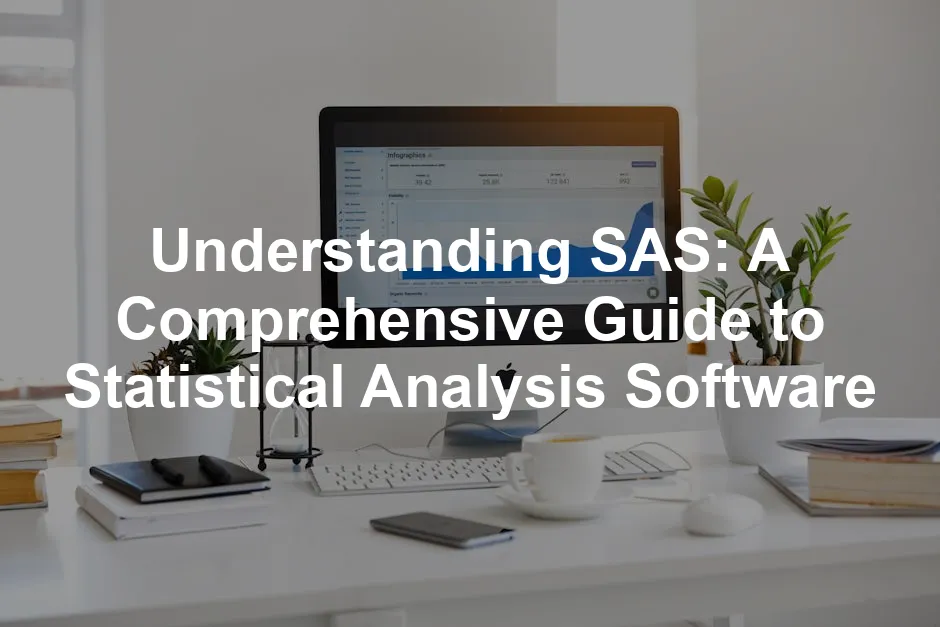Introduction
Have you ever wondered how companies make sense of massive data? Meet SAS, short for Statistical Analysis System. This powerful analytics software is essential for data management, advanced analytics, and business intelligence. It helps businesses turn raw data into actionable insights. In this article, we’ll provide a thorough understanding of SAS, highlighting its features, applications, and benefits.
Summary and Overview
SAS was founded in 1976, starting as a tool for agricultural research. Over the decades, it has transformed into a leading analytics platform. Today, SAS excels in statistical analysis, data mining, and predictive analytics. Its global presence spans various industries, from healthcare to finance.
Key products include SAS Viya software, SAS Enterprise Guide software, and SAS Visual Analytics software. Each offers unique functionalities tailored to different analytics needs. This article will guide you through SAS’s evolution, core features, and real-world applications. Expect to learn practical insights that can help you leverage SAS for your own purposes.

The Evolution of SAS
History and Development
SAS began in the 1970s, primarily aiding agricultural research. As demand for data analysis grew, SAS expanded its functionalities. In the 1980s, it introduced its first graphical user interface. This leap made the software more accessible to users.
Major milestones include the launch of SAS 9 in 2004, which introduced enhanced data management capabilities. In recent years, partnerships with cloud providers have further propelled SAS’s growth. This shift allows organizations to harness the power of analytics in the cloud, enhancing agility and scalability. Today, SAS remains a trusted name in analytics, impacting businesses globally.
Key Milestones
SAS was founded in 1976, initially focusing on agricultural research. Its original applications helped farmers analyze crop data effectively. This foundation laid the groundwork for its evolution into a powerful analytics platform.
In 2016, SAS introduced SAS Viya. This cloud-native platform transformed the analytics landscape. It provides users with a unified experience for data preparation, analytics, and deployment. Organizations now enjoy faster processing and improved collaboration across teams. With SAS Viya, businesses can harness the power of AI and machine learning more efficiently than ever.
To understand the impact of advanced analytics, consider exploring predictive analytics for Croatia men’s national basketball team performance 2024.
SAS has also earned notable awards and recognitions over the years. It consistently ranks high in industry reports. Recently, SAS was named a leader in The Forrester Wave™ for AI/ML Platforms. Such accolades highlight its commitment to innovation and excellence in analytics.

Core Features of SAS
Advanced Analytics
Advanced analytics in SAS refers to using sophisticated techniques for data analysis. This includes predictive modeling, data mining, and machine learning. These techniques help organizations uncover hidden patterns and forecast future outcomes.
For example, the healthcare industry uses predictive modeling to anticipate patient needs. Retailers apply data mining to enhance customer experiences. Financial services leverage machine learning for fraud detection. Each industry benefits from these advanced features, driving better decision-making. If you’re looking to dive deeper into the world of predictive analytics, consider picking up Predictive Analytics: The Power to Predict Who Will Click, Buy, Lie, or Die by Eric Siegel. It’s a fantastic read for anyone wanting to understand the art of forecasting!

Data Management
SAS excels in data management capabilities. It enables seamless data integration from various sources. This ensures that organizations can access and analyze data efficiently.
Quality management is another key feature. SAS helps businesses maintain high data quality through rigorous validation processes. Additionally, effective governance practices ensure compliance with data regulations. Statistics show that organizations using SAS experience a 30% increase in data handling efficiency. For those seeking to master data management, Data Mining: Concepts and Techniques by Jiawei Han is a must-read!

Business Intelligence
SAS supports business intelligence initiatives robustly. It offers powerful reporting, visualization, and dashboard functionalities. These tools help organizations turn data into actionable insights.
Businesses leverage SAS for strategic decision-making. For instance, a global retailer used SAS to optimize inventory levels, saving millions. Another case study features a bank that improved customer satisfaction through enhanced analytics. These real-world examples showcase the tangible benefits SAS offers to organizations across industries. If you’re interested in honing your data visualization skills, check out Storytelling with Data: A Data Visualization Guide for Business Professionals by Cole Nussbaumer Knaflic. It’s the perfect guide for turning your data into engaging stories!

SAS Products and Solutions
SAS Viya
SAS Viya is a cloud-native analytics platform. It offers powerful capabilities for data processing and analysis. With SAS Viya, users benefit from improved scalability. This means you can easily adjust resources based on demand. Performance is significantly enhanced compared to traditional SAS software.
The intuitive interface makes it user-friendly for everyone. You don’t need extensive training to get started. Moreover, SAS Viya supports multiple programming languages. This flexibility allows you to work in the environment you prefer. In contrast, traditional SAS software is more rigid and often requires specific skills. SAS Viya truly modernizes the analytics experience. For those wanting to learn more about data science, grab a copy of Data Science for Business: What You Need to Know about Data Mining and Data-Analytic Thinking by Foster Provost. It’s a great entry point into the field!

SAS Enterprise Guide
SAS Enterprise Guide is designed to simplify data analysis. It provides a visual interface that makes complex tasks easier. Analysts can quickly create reports and perform analyses without deep coding knowledge.
This tool is especially valuable for business users. They can access analytics without needing to understand complex programming. Features include drag-and-drop functionality, making it intuitive and accessible. You can easily connect to various data sources and perform tasks efficiently. By streamlining processes, SAS Enterprise Guide empowers users to make data-driven decisions quickly. For those interested in a structured learning path, consider taking Tableau Desktop for Beginners by Udemy. It’s a fantastic way to get started with data visualization!

SAS Visual Analytics
SAS Visual Analytics is all about data visualization. It helps users create interactive dashboards and reports. The main functions include visual data exploration and insightful reporting. With its user-friendly interface, you can easily spot trends and patterns.
Organizations like retailers and healthcare providers use SAS Visual Analytics. For instance, a major retailer improved sales strategies by analyzing customer behavior. Meanwhile, a healthcare organization utilized it to enhance patient care through data insights. This platform enables users to present data compellingly, making insights clear and actionable. If you’re looking to start your data analysis journey, I recommend Python for Data Analysis: Data Wrangling with Pandas, NumPy, and IPython by Wes McKinney. It’s a great resource for beginners!

Use Cases for SAS
Industries Leveraging SAS
SAS is widely used across various sectors. In healthcare, it supports patient outcomes through predictive analytics. Hospitals use SAS to analyze treatment effectiveness and optimize resource allocation.
The finance industry also benefits from SAS analytics. Banks leverage its capabilities for fraud detection and risk management. For example, a leading bank used SAS to reduce fraud incidents significantly. If you’re interested in understanding the science behind data, The Art of Statistics: Learning from Data by David Spiegelhalter is an excellent read!
Retailers utilize SAS to enhance customer experiences. Companies analyze buying patterns to tailor marketing efforts. These implementations show how SAS drives efficiency and informed decision-making across industries.
Academic and Research Applications
SAS plays a vital role in academic settings. Researchers utilize this software for data analysis and statistical modeling. Its robust features support various disciplines, from social sciences to health studies. The ability to analyze complex datasets makes SAS a preferred choice among academics.
Many educational institutions partner with SAS for training and development. These collaborations often involve workshops, seminars, and certification programs. Such initiatives equip students with essential skills in analytics. This knowledge is invaluable as they enter the workforce.
Moreover, SAS offers free resources for students and researchers. Through programs like SAS OnDemand for Academics, users can access software at no cost. This initiative encourages learning and experimentation in data analysis. By providing these resources, SAS fosters a new generation of data-savvy professionals. If you’re a beginner looking to dive into data science, consider grabbing Data Science for Dummies by Judith Hurwitz. It’s an excellent starting point!

The Future of SAS
Innovations and Trends
SAS continues to innovate, introducing exciting features in its technology. Upcoming enhancements focus on improving user experience and performance. Features like real-time analytics and cloud capabilities are on the horizon. These developments aim to keep SAS at the forefront of the analytics landscape.
In the realm of data analytics, trends are constantly evolving. SAS adapts to these shifts by integrating advanced technologies. The rise of big data necessitates tools that can handle vast amounts of information seamlessly. SAS is committed to staying relevant and responsive to market demands.
A significant focus for SAS is its commitment to AI and machine learning. By enhancing these capabilities, SAS aims to provide deeper insights from data. This focus positions SAS as a leader in predictive analytics and automation. As organizations seek smarter solutions, SAS is ready to meet those needs. For those wanting a deeper dive into machine learning, Machine Learning Yearning by Andrew Ng is a great resource!

Community and Support
The SAS user community plays a crucial role in its ecosystem. This vibrant network fosters collaboration and knowledge sharing. Users can connect through forums and discussion boards, exchanging ideas and solutions.
SAS provides extensive resources for its community. Documentation, tutorials, and training programs are readily available. These materials help users maximize their experience with SAS software. Additionally, online courses offer structured learning paths for all skill levels. If you’re looking for a comprehensive understanding of data warehousing, check out The Data Warehouse Toolkit: The Definitive Guide to Dimensional Modeling by Ralph Kimball. It’s a classic in the field!

SAS actively promotes collaboration among users. Events like SAS Global Forum allow professionals to network and learn from each other. This sense of community enhances the overall experience and encourages continuous learning. By nurturing these connections, SAS helps users grow and succeed in their analytics journeys.

FAQs
What is SAS used for?
SAS is widely used for data analysis across industries. It supports applications like predictive analytics, statistical modeling, and data management. Industries such as healthcare, finance, and retail utilize SAS to derive insights and enhance decision-making.
Is SAS suitable for beginners?
Yes, SAS is suitable for beginners. While it has a learning curve, there are plenty of resources available. Tutorials, online courses, and community forums make it easier for new users to get started.
How does SAS compare to other analytics software?
SAS offers unique advantages over competitors like R, Python, and Tableau. Its comprehensive suite of tools is user-friendly and designed for enterprise-level needs. While R and Python are great for coding enthusiasts, SAS provides a more guided experience.
Can I use SAS for free?
Yes, you can use SAS for free through trials and educational programs. SAS offers OnDemand for Academics, allowing students to access the software without cost. This initiative supports learning and exploration.
What are the system requirements for SAS?
To run SAS effectively, you need a compatible operating system, sufficient RAM (typically 8GB or more), and adequate disk space. Specific requirements may vary based on the SAS product you choose. Always check the official documentation for the latest details.
Please let us know what you think about our content by leaving a comment down below!
Thank you for reading till here 🙂
All images from Pexels




